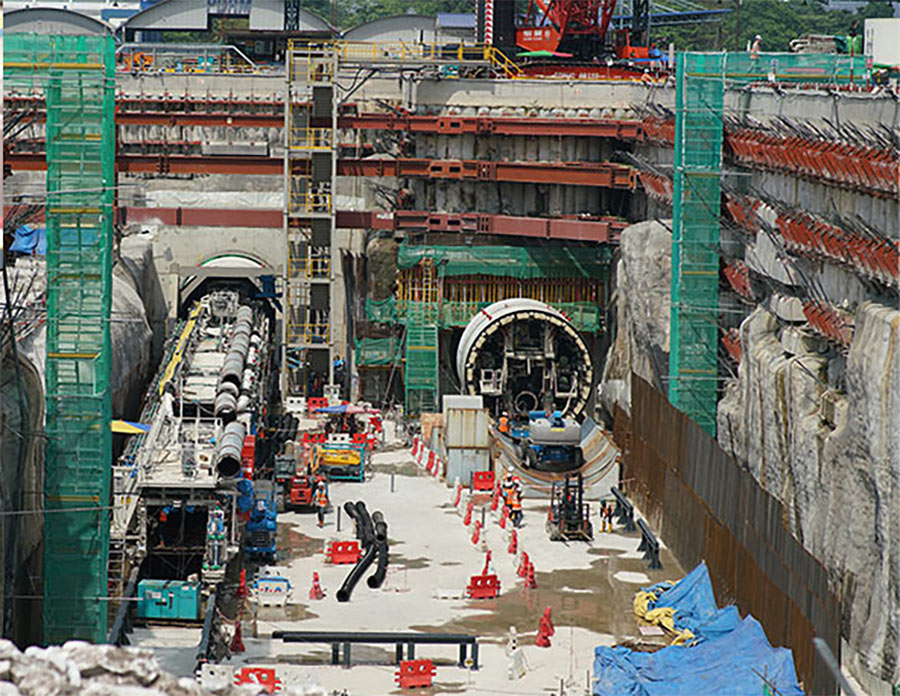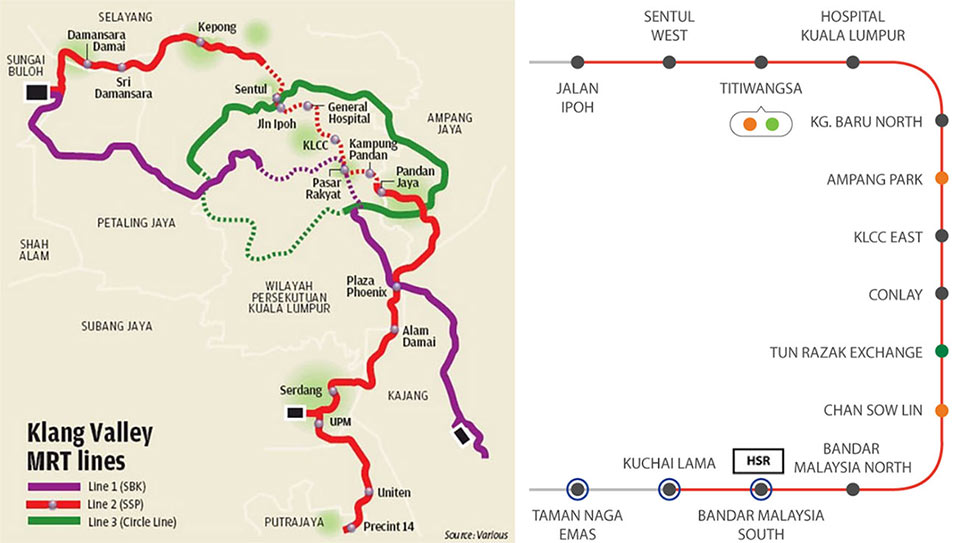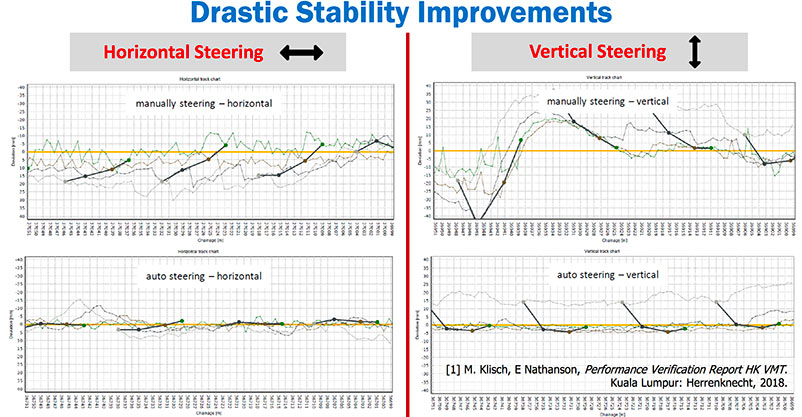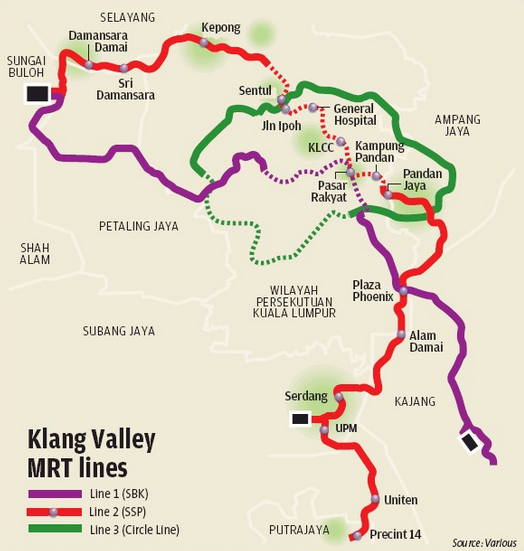Kuala Lumpur plans for metro line three 19 Nov 2020
There is good news in Malaysia for development of Line 3 of the Klang Valley Mass Rapid Transit, building on the successes of the Line 1, which opened in July 2017, and construction of Line 2 progressing towards an opening in January 2023. In his 2021 budget presentation on 6 November, Minister of Finance Tengku Zafrul Aziz confirmed that the Malaysian Government has allocated funds for 2021 to advance the third line of the KVMRT.
At about 40km long, Line 3 was in planning and design under the previous national government administration of Malaysia and has an estimate of US $11 billion, with a significant section in the centre of Kuala Lumpur running underground. The line was planned as a circle line to integrate the public transport system in the Klang Valley (Fig 1). At the end of 2018, the MMC-Gamuda JV, which completed Line 1 and is currently completed Line 2, resubmitted an alternative proposal for MRT Line 3. The proposal stated construction could take place in several phases, with the first phase costing about $5 billion.
Since announcement of funding allocation in the 2021 budget, focus has turned to discussing the preferred business model for delivering Line 3 with different structures being explored. A project delivery partner model (PDP) option, as used on the Line 1 project, could expedite construction work and ensure a timely completion. A turnkey model, as applied under a restructure of Line 2 in late 2018 to reduce cost, is another option. The Gamuda and MMC partnership that has worked on both Line 1 and Line 2 stand out as the obvious contractors for Line 3. According to analysts speaking to local newpaper The Star, "awarding the project to a MMC-Gamuda joint venture would provide continuity in construction activities after the completion of MRT2 in 2022.” The timing and funding structure for MRT3 is expected to be addressed in the medium term Covid-19 pandemic recovery plan by the Government in December.
MRT3 is a project ready for procurement and if awarded to MMC-Gamuda the economic benefits could be maximised in the shortest possible time frame. Speaking to The Star, Alliance DBS Analyst Chong Tjen San is reported as saying that if awarded on a turnkey contract, the benefit impact would filter down through the economy more quickly while the PDP model could be explored to minimise risk and capitalise on the current low interest rate environment. A certainty is that a delay between the end of the Line 2 construction and start of Line 3 will cause the current experienced management and construction teams to disband and cost more time and money to restructure and re-establish.
References
- MRT metro excavation complete in Kuala Lumpur – TunnelTalk, Nov 2020
- Back from brink for KVMRT underground works – TunnelTalk, Nov 2018
- KVMRT to repeat Line 1 success for Line 2 – TunnelTalk, Apr 2016
- Kuala Lumpur opens tunnel Training Academy – TunnelTalk, December 2011
MRT metro excavation complete in Kuala Lumpur 12 Nov 2020
All excavation for the 13.5km central underground section of the 52km Putrajaya Line 2 of the KVMRT, Klang Valley Mass Rapid Transit, in Kuala Lumpur is complete with installation of track, signalling systems and mechanical and electrical equipment progressing towards an opening of the line by January 2023.

From launch of first two machines in March 2018 to last ring erected in October 2020, 27km of TBM excavation completed in 31 months
The last rings of segmental lining for 11.5km of twin running tunnels between 10 open cut underground stations and an open cut crossover structure were erected by the last operating TBMs in October. With no opportunity to breakthrough into the operating Tun Razak Exchange underground interchange station with the Kajang Line 1, the four TBM drives arrived at the station walls for the machine components being retrieved back through the completed tunnels and working shafts (Fig 1). Junctions to the live station will be executed by hand tools and the sacrificial TBM shields finished with a cast concrete inner lining.
The end of all excavation for the Putrajaya Line, which also includes two ventilation shafts, three access shafts and nine cross passages, is celebrated by MMC-Gamuda after launching the first pair of TBMs in March 2018 and completing the total 23km running tunnels in 31 months across 16 separate drives, using 12 TBMs and executing four blind endings and four TBM retrievals for transport and relaunch for second drives. The nine cross passages have been excavated by open face excavators and under the support of ground treatment. Installation of the finishing works in the tunnels and the open cut stations began in mid-2020 and are progressing at pace.

Scope of the Klang Valley MRT with all excavation of the central section of the red Putrajaya Line 2 now complete
Eight of the machines used for the running tunnel drives are Herrenknecht Variable Density TBMs, developed specifically to work through the unpredictable karstic limestone of the Kuala Lumpur region. The TBMs are designed to convert efficiently between EPB and slurry mode and to vary the density of the bentonite slurry to prevent loss through the porous and karstic limestone or escape under pressure to the surface. EPB mode provides for bypass of the slurry circuit in more favourable conditions and extraction of excavated muck via the screw conveyor (that stays in place in both modes) and haulage via continuous conveyor. The other four machines are EPBMs working through the more predictable deposits of the Kenny Hill formation.
The Gamuda tunnelling team built on the experiences of its previous Kajang Line 1 project to build seven underground stations and 9.5km of twin running tunnels, and before that its engagement on excavation and construction of the combined stormwater management and road tunnel SMART project, both largely through karstic limestone. The current Putrajaya Line route is deeper than the previous project alignments and through more complex geological interfaces. The drives also pass under sensitive existing infrastructure including under the previous Kajang Line and SMART tunnel alignments.

Gamuda has created a skilled and well experienced tunnelling team
On the Putrajaya Line, the Gamuda TBM tunnelling team also developed and deployed an autonomous TBM operating system that provided automatic management of excavation variables in faster reaction times than possible by human TBM operators. The system was used on 10 of the Putrajaya Line TBMs and the experience has confirmed that it improved overall productivity, safety and quality of tunnel construction. The system has been recognised in the international industry with two innovation awards: the Technical Equipment Innovation of the Year Award of the 2019 International Tunnelling and Underground Space Association (ITA) Tunnelling Awards; and the Innovation in Tunnel Excavation Award at the UK Tunnelling Festival Awards.
Through its experiences, the Gamuda team has also worked under and through different contractual and political arrangements.
For the SMART Tunnel, the complete works construction was awarded as a design-build contract and managing a sub-contractor for the second of the two TBM drives and further subcontractors for M&E supply and installations. On the first KVMRT Line, Gamuda, in JV with MMC, was the underground works contractor on a design-build basis with the scope including the station fitouts for lighting, ventilation, escalators, platform screen doors, telecommunication systems and others. The systemwide contracts for track work, power supply, train control and signalling, as well as the civil contracts for the elevated sections of the line were managed by the Project Delivery Partner (PDP), which was also a MMC-Gamuda entity, and on a direct target cost + fee contract basis with the client.

Comparison of steering accuracy between a human operator (above) and autonomous TBM operation (below)
For the Putrajaya Line 2, the contractual arrangement was the same as Line 1 at the start. The situation changed when a new Government administration was elected in Malaysia and it decided first to cancel, later reinstate and then renegotiate the contracts with MMC-Gamuda for the underground works. Through negotiation the Underground Works contractor and the PDP (both including Gamuda entities) were merged to form a turnkey contractor where all the separate works package contracts were novated to the new turnkey contractor arrangement. This grouping into a turnkey procurement arrangement included the underground works, all the separate systemwide contracts and the elevated section civil contracts, and was required as a cost saving exercise to reduce the original underground contract by 21.5%, from US$3.99 billion to $3.1 billion. The cost savings exercise also postponed finishing works of two excavated and structurally built underground stations at Bandar Malaysia North and Bandar Malaysia South, to a future date and under a different contract. Under the new arrangement, the total cost of the full 52km long MRT Line 2 was reduced by 22.4%, from US$9.4 billion to $7.3 billion.
Having navigated the contractual administration upheaval, the project has also been impacted by the Covid-19 pandemic of 2020 with extra precautions in place to prevent the spread of the virus through the workforce. For the underground excavation works, a dispensation was granted under the essential works directive, to keep the TBMs and excavation works progressing.
Complex re-sequencing and re-coordination of the systems installation programme was necessary to keep to the committed line opening date, as published to the public. Given the delays incurred, firstly by the contractual upheaval and then the temporary slowing of work and reduced productivity brought about by pandemic restrictions, there is now a significantly increased overlap between the civils and systems phases, necessitating some late stage re-design to accommodate the revised installation sequencing of the accelerated coordination programme.
Gamuda, in its initial role as the Project Delivery Partner and now as the Turnkey Contractor, has come full circle on the project with top-to-toe accountability for project delivery throughout its construction phase. Gamuda was the initial proponent of an MRT scheme for Kuala Lumpur and was responsible for the pre-construction phase from securing approval for the railway scheme to engineering design and procurement packaging for the client and now delivering the final phase of construction in its Turnkey Contractor capacity.
With overall project progress currently at 82%, and having faced and successfully navigated the challenges - both geologically, logistically, contractually and politically - the new 52km long Putrajaya Line, including its 13.5km underground central section, is on track for opening to public service by January 2023.
References
- KVMRT to repeat Line 1 success for Line 2 – TunnelTalk, April 2016
- New design TBM tames the Kuala Lumpur karst – TunnelTalk, January 2014
- Award-winning autonomous TBM operations – TunnelTalk, December 2019
- Kuala Lumpur opens tunnel Training Academy – TunnelTalk, December 2011
- Back from brink of termination for KVMRT underground works – TunnelTalk, November 2018
|
|
|
|
|
Add your comment
- Thank you for taking the time to share your thoughts and comments. You share in the wider tunnelling community, so please keep your comments smart and civil. Don't attack other readers personally, and keep your language professional.


